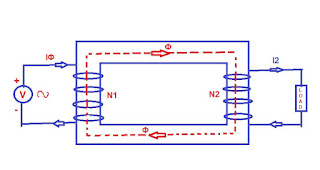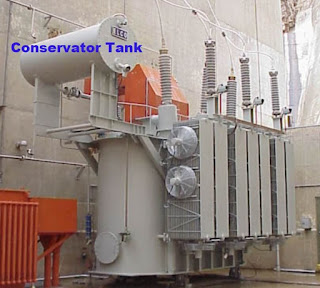The working principle of the transformer is based on Faraday’s law of electromagnetic induction. The three-phase power transformer is the main device of every power system. the main function of transformer is to step up or step down the voltage level.
Considering the insulation part of the generator, the generation of electrical power is limited to 11KV to 22KV, but to transmit power at a higher voltage level i.e 132KV or more is economical because of losses in lower voltage transmission is more and larger conductor size is required due to higher current. here we will see the function of transformer its working principle, Construction, and advantages.
Every ac power transmission line starts with a three-phase electrical transformer and ends with it by stepping down 3-phase high voltage to a usable level using a step-down type transformer i.e 415V for three-phase and 215V for single phase user.
What is electrical Transformer
The electrical transformer is a static piece device means it does not have any moving parts in it. that’s why the efficiency of it is high compared to other electrical machines.
The basic function of transformer is it transfer energy from one electrical circuit to another circuit through a magnetic field. Hence also called an electromagnetic energy conversation device.
The circuit that transfers energy is called primary winding and which receives energy is referred to as the secondary winding of a transformer which is further connected to the load.
Here mainly to Note that primary and secondary are not connected electrically to each other but connected magnetically.
Magnetic coupling allows transferring energy from a higher voltage level to a lower level or from low voltage to higher i.e energy transfer in either direction.
The transformer converts voltage levels from one voltage to other voltage levels without a change in frequency or power.
Transformer Working Principle

Transformer works on the principle of Faraday’s law of electromagnetic induction. According to Faraday’s law, an emf is induced in a coil if it links to changing flux.
When primary winding is fed with ac supply voltage ” V1 ” therefore an ac current ” IФ ” starts flowing through winding N1 turns.
Alternating MMF N1 creates alternating flux ϕ which starts flowing through the magnetic core and links to the secondary winding and induced voltage E2 in the secondary winding due to transformer action.
If a load is connected across the secondary of the electrical transformer, current starts flowing in the secondary through the load.
Construction of the transformer
Magnetic core
The magnetic core is made up of magnetic material like CRGO (cold-rolled grain-oriented steel). this material has high permeability.
The core is a stack of thin silicon-steel lamination to reduce eddy current losses and separate from each other by using thin layers of varnish.
Winding
Winding is made up of a copper conductor and wound on a magnetic core.
- In a core-type transformer, most of the part of the core is surrounded by winding.
- On the other hand shell-type transformer core surround a major part of the winding.
- The advantage of the core type is it reduced core material but required more copper for winding
- shell-type required less conductor material but more core material.
- The vertical portion of the X’mer is called a limb and the horizontal portion is called a yoke.
- 1 phase shell-type transformer has 3 limbs and a winding wound on the central limb and a core type has two limbs and a winding wound on both limbs.
Conservator

Transformer oil should not be allowed to come in contact with atmospheric air as it may take up moisture resulting reduction in the dielectric strength of the oil. also, air may cause acidity and sludging of oil. To prevent this transformer provided with a conservator.
The function of a conservator is to take up the contraction and expansion of transformer oil during working without allowing it to come in contact with outside air.
The conservator consists of an airtight metal drum-like structure fitted above the transformer top and connected to it by a pipe.
The main tank is completely filled with oil when cold.
The conservator tank is partially filled with oil. So space for the expansion of oil is provided and the sludge formed remains in the conservator itself and does not go to the main tank.
Breather
When temperature changes, the oil expands or contracts and there is a movement of air takes place. When the transformer cools down, the oil level goes down and the air is drawn inside. this process is known as breathing. the function of the breather is to allow moisture-free air inside the transformer during the breathing process of the transformer.
The air, drawn in is passed through a breather for removing moisture from the air.
The breather consists of a small vessel containing a silica gel crystal impregnated with cobalt crystal.
Advantages of transformer
- Used for stepping up or down supply voltage.
- High efficiency compared to other electrical machines.
- with the use of a transformer, long-distance ac power transmission is possible.
- Distribute power at high voltage.
- Insulate circuits/establish separately derived circuits.
- Provide 3-wire secondary circuits.
- Provide electrostatic shielding transient noise protection.
